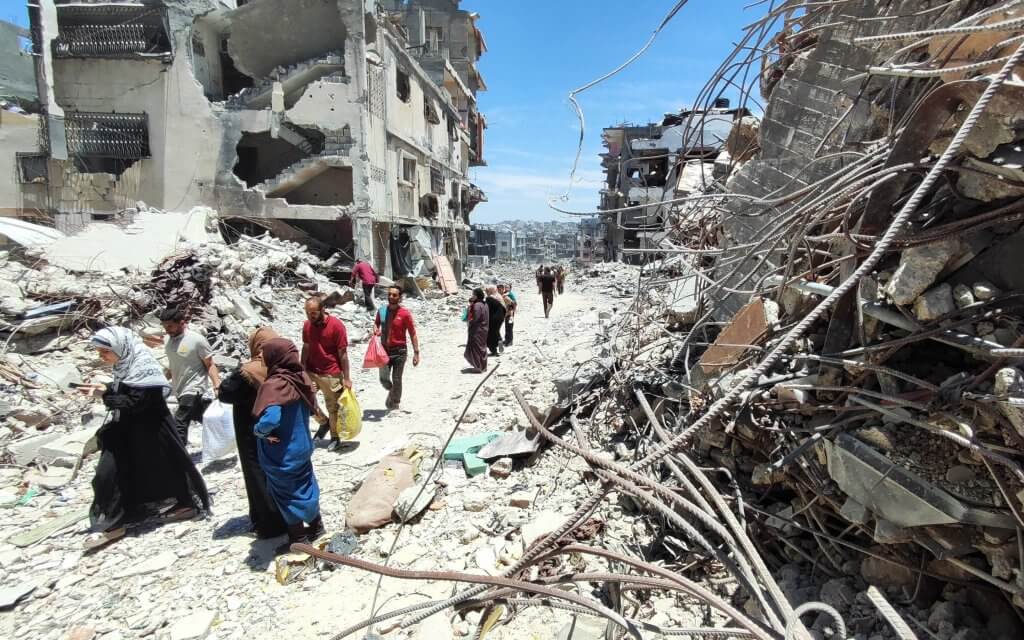June 1, 2024
After a bloody 3-week invasion, the Israeli army
finally withdrew from central parts of the Jabalia refugee camp, remaining in
central locations on the outskirts of Jabalia and Beit Lahia. It left
devastation in its wake.
 Palestinians return to their homes following the withdrawal of the
Israeli army from the Jabalia area in the northern Gaza Strip. (Photo:
Khaled Daoud/APA Images)
Palestinians return to their homes following the withdrawal of the
Israeli army from the Jabalia area in the northern Gaza Strip. (Photo:
Khaled Daoud/APA Images) This is the second time that the army has launched a
ground invasion of the camp and its neighboring town. At the start of the year,
Israel had declared the end of the “intensive” phase of fighting in northern
Gaza, withdrawing from Jabalia and other parts of the north after having
supposedly “dismantled” Hamas’s military presence there. Almost five months
later, the resistance had already regrouped in the north. By early May, the
second invasion of Jabalia, the al-Zaytoun neighborhood, and the Tuffah area commenced,
but three days in, the Israeli army withdrew from al-Tuffah and al-Zaytoun,
east of Gaza City. Jabalia, however, was different.
Most reports kept repeating the same mantra: the
fighting in Jabalia this time around was fiercer and more violent than the
first invasion. It could be noticed in the marked rise of Israeli military
casualties since the start of the Rafah invasion to the south. Resistance
factions launched repeated salvos of rockets toward Israel, targeted Israeli
tanks on the ground in Jabalia with mortar fire and RPGs, and shot at soldiers
in sniping operations. Footage of those operations was broadcast online and on Aljazeera’s
round-the-clock coverage.
But what was most significant about the Jabalia
invasion was the news that the Qassam Brigades had captured more Israeli
soldiers in an ambush on May 26.
The media spokesperson for the Qassam Brigades, Abu
Obaida, announced that resistance fighters had targeted 100 Israeli tanks in
ten days.
“The Israeli enemy is entering hell again in Gaza,
facing more resistance,” Abu Obaida said. “They thought that they would not
encounter significant resistance. But they were surprised and confronted with
stronger fighting than the first day of the ground invasion.”
The military spokesman also stated that fighters
targeted an Israeli force in an ambush, and had managed to capture several
soldiers, vowing that more details would be released at a later date.
On the first day in Jabalia, Israel leveled over 300
houses, clearing the rubble with D9 bulldozers to pave the way for the entry of
tanks inside the camp. People in the camp started telling each other that it
looked like the same operation Israel had launched during its second invasion
of al-Shifa Hospital, where it massacred hundreds of Palestinians and buried
them in mass graves. When the graves were unearthed, many of the bodies were
found with hands bound and medical catheters still attached.
Knowledge of what happened at al-Shifa drove people
to attempt to leave Jabalia when the invasion began, fearing that they would
meet the same fate. Yet a considerable number of people also remained.
Jabalia refugee camp is considered one of the most
essential popular bases of the Hamas movement. Due to the significant number of
resistance members who lived there, it came to be called “Jabalia military
camp” (mu’askar Jabalia). In 1987, the spark of the First Intifada was lit in
Jabalia. The camp’s terrain is composed of densely packed buildings with
complex and narrow alleyways that can only accommodate two people walking
abreast. Anyone who grew up in the camp and later became a resistance fighter
was able to move around the battlefield that was once their home with speed and
intimate familiarity.
When the Israeli army stormed Jabalia for the second
time, thinking it would crush the camp, it was surprised that the fighters had
been well-prepared. The number of Israeli casualties reported through the news
began to climb. Israeli media reported soldiers’ frustration at going into
Jabalia a second time without results.
Due to the indiscriminate artillery shelling of all
areas of the camp, some families left Jabalia for less targeted parts of
northern Gaza. At the same time, those who remained witnessed fierce battles,
and new resistance tactics lured Israeli soldiers to several ambushes.
During the past 3 weeks, the resistance in Jabalia
and northern Gaza used new air defense weapons against helicopters and
reconnaissance drones, some of which it shot down.
Mirroring the tenacity of the resistance fighters,
camp residents also attempted to embody steadfastness by remaining in their
homes.
Ahmad Abu Khater, 34, lives in Jabalia, and did not
leave the camp at any point since the start of the war. He told Mondoweiss that
he witnessed Israeli soldiers enter dozens of demolished homes that had been
bombed by Israeli aircraft in advance, and he saw those same homes explode
after the soldiers had entered. He also reported witnessing how Israeli
military concentrations were targeted with mortar shells.

No comments:
Post a Comment